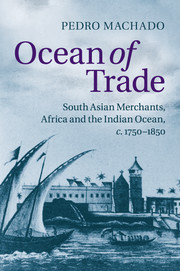Refine search
Actions for selected content:
26946 results in Economic history

The Illustrated Record of the International Exhibition ... of All Nations, in 1862
-
- Published online:
- 05 November 2014
- Print publication:
- 20 March 2014

The Popular Guide to the International Exhibition of 1862
-
- Published online:
- 05 November 2014
- Print publication:
- 20 March 2014

Ocean of Trade
- South Asian Merchants, Africa and the Indian Ocean, c.1750–1850
-
- Published online:
- 05 November 2014
- Print publication:
- 06 November 2014
CHAPTER III - PRIVATE SCHOOL
-
- Book:
- Life of Sir John Lubbock, Lord Avebury
- Published online:
- 05 June 2015
- Print publication:
- 30 October 2014, pp 10-14
-
- Chapter
- Export citation
CHAPTER XVIII - SECOND MARRIAGE
-
- Book:
- Life of Sir John Lubbock, Lord Avebury
- Published online:
- 05 June 2015
- Print publication:
- 30 October 2014, pp 192-210
-
- Chapter
- Export citation
CHAPTER XLV - TEMPORARY RECOVERY
-
- Book:
- Life of Sir John Lubbock, Lord Avebury
- Published online:
- 05 June 2015
- Print publication:
- 30 October 2014, pp 305-313
-
- Chapter
- Export citation
CHAPTER X - FIRST STANDING FOR PARLIAMENT
-
- Book:
- Life of Sir John Lubbock, Lord Avebury
- Published online:
- 05 June 2015
- Print publication:
- 30 October 2014, pp 66-80
-
- Chapter
- Export citation
CHAPTER XXV - GIVES UP CHAIRMANSHIP OF L.C.C.
-
- Book:
- Life of Sir John Lubbock, Lord Avebury
- Published online:
- 05 June 2015
- Print publication:
- 30 October 2014, pp 317-338
-
- Chapter
- Export citation
CHAPTER XXXVI - WORK IN THE UPPER HOUSE
-
- Book:
- Life of Sir John Lubbock, Lord Avebury
- Published online:
- 05 June 2015
- Print publication:
- 30 October 2014, pp 173-194
-
- Chapter
- Export citation
CHAPTER VII - SCIENCE AND MARRIAGE
-
- Book:
- Life of Sir John Lubbock, Lord Avebury
- Published online:
- 05 June 2015
- Print publication:
- 30 October 2014, pp 36-45
-
- Chapter
- Export citation
CHAPTER XXXI - ISSUE OF “BEST HUNDRED BOOKS”
-
- Book:
- Life of Sir John Lubbock, Lord Avebury
- Published online:
- 05 June 2015
- Print publication:
- 30 October 2014, pp 89-101
-
- Chapter
- Export citation
CHAPTER XIV - SCIENCE AND POLITICS
-
- Book:
- Life of Sir John Lubbock, Lord Avebury
- Published online:
- 05 June 2015
- Print publication:
- 30 October 2014, pp 135-152
-
- Chapter
- Export citation
CHAPTER IX - SCIENCE, AND THOUGHTS OF PARLIAMENT
-
- Book:
- Life of Sir John Lubbock, Lord Avebury
- Published online:
- 05 June 2015
- Print publication:
- 30 October 2014, pp 52-65
-
- Chapter
- Export citation
WORKS BY LORD AVEBURY
-
- Book:
- Life of Sir John Lubbock, Lord Avebury
- Published online:
- 05 June 2015
- Print publication:
- 30 October 2014, pp 335-336
-
- Chapter
- Export citation
CHAPTER XX - “THE PLEASURES OF LIFE”
-
- Book:
- Life of Sir John Lubbock, Lord Avebury
- Published online:
- 05 June 2015
- Print publication:
- 30 October 2014, pp 235-249
-
- Chapter
- Export citation
CHAPTER XLI - ADDRESSES IN SCOTLAND
-
- Book:
- Life of Sir John Lubbock, Lord Avebury
- Published online:
- 05 June 2015
- Print publication:
- 30 October 2014, pp 253-262
-
- Chapter
- Export citation
INTRODUCTION
-
- Book:
- Life of Sir John Lubbock, Lord Avebury
- Published online:
- 05 June 2015
- Print publication:
- 30 October 2014, pp xi-xvi
-
- Chapter
- Export citation
CHAPTER XXIX - “THE SCENERY OF SWITZERLAND”
-
- Book:
- Life of Sir John Lubbock, Lord Avebury
- Published online:
- 05 June 2015
- Print publication:
- 30 October 2014, pp 59-75
-
- Chapter
- Export citation
CHAPTER XXI - “NATIONALITIES” AND POLITICS
-
- Book:
- Life of Sir John Lubbock, Lord Avebury
- Published online:
- 05 June 2015
- Print publication:
- 30 October 2014, pp 250-265
-
- Chapter
- Export citation
CHAPTER XXIII - CHAIRMANSHIP OF LONDON COUNTY COUNCIL
-
- Book:
- Life of Sir John Lubbock, Lord Avebury
- Published online:
- 05 June 2015
- Print publication:
- 30 October 2014, pp 290-306
-
- Chapter
- Export citation
